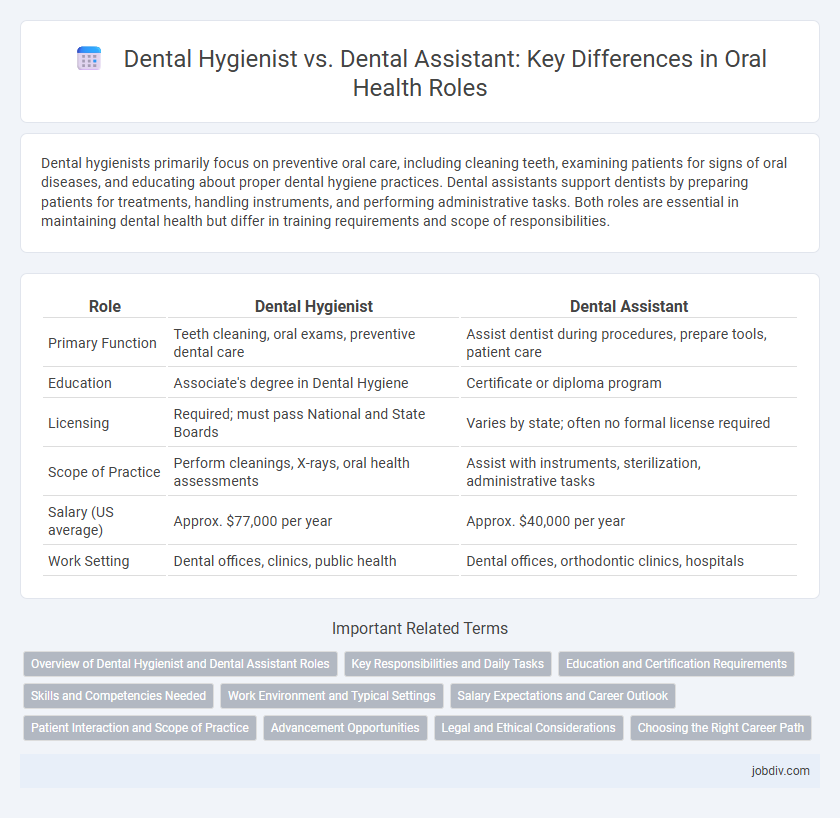Dental hygienists primarily focus on preventive oral care, including cleaning teeth, examining patients for signs of oral diseases, and educating about proper dental hygiene practices. Dental assistants support dentists by preparing patients for treatments, handling instruments, and performing administrative tasks. Both roles are essential in maintaining dental health but differ in training requirements and scope of responsibilities.
Table of Comparison
| Role | Dental Hygienist | Dental Assistant |
|---|---|---|
| Primary Function | Teeth cleaning, oral exams, preventive dental care | Assist dentist during procedures, prepare tools, patient care |
| Education | Associate's degree in Dental Hygiene | Certificate or diploma program |
| Licensing | Required; must pass National and State Boards | Varies by state; often no formal license required |
| Scope of Practice | Perform cleanings, X-rays, oral health assessments | Assist with instruments, sterilization, administrative tasks |
| Salary (US average) | Approx. $77,000 per year | Approx. $40,000 per year |
| Work Setting | Dental offices, clinics, public health | Dental offices, orthodontic clinics, hospitals |
Overview of Dental Hygienist and Dental Assistant Roles
Dental hygienists specialize in preventive oral care, performing tasks such as teeth cleaning, examining patients for signs of oral diseases, and educating about proper dental hygiene. Dental assistants support dentists by preparing patients for procedures, sterilizing instruments, and managing administrative duties. Both roles are essential for maintaining dental office efficiency and promoting patient oral health.
Key Responsibilities and Daily Tasks
Dental hygienists perform teeth cleanings, patient assessments, and apply preventive treatments such as sealants and fluoride, playing a crucial role in oral health maintenance. Dental assistants support dentists by preparing patients for procedures, handling instruments, taking X-rays, and managing administrative tasks in dental offices. Both roles require knowledge of dental practices, infection control, and patient care, but hygienists focus more on preventive treatments while assistants emphasize chairside support and clinical assistance.
Education and Certification Requirements
Dental hygienists typically require an associate degree in dental hygiene, which usually takes about two years to complete, alongside passing the National Board Dental Hygiene Examination and obtaining state licensure for practice. Dental assistants often receive on-the-job training or complete a postsecondary dental assisting program lasting about one year, with certification such as the Certified Dental Assistant (CDA) credential offered by the Dental Assisting National Board enhancing job prospects. Both roles demand strict adherence to continuing education requirements to maintain certification and stay updated on dental care advancements.
Skills and Competencies Needed
Dental hygienists require advanced clinical skills in teeth cleaning, oral health assessments, and patient education, often utilizing periodontal instruments and radiographic technology. Dental assistants need proficiency in chairside assisting, sterilization procedures, and administrative tasks, including scheduling and record-keeping. Strong communication, attention to detail, and knowledge of dental anatomy and infection control protocols are essential competencies for both roles.
Work Environment and Typical Settings
Dental hygienists typically work in private dental offices, specializing in preventative oral care and patient education, often having more direct patient interaction in well-lit, sterile environments. Dental assistants operate in a variety of settings including dental offices, orthodontic clinics, and oral surgery centers, providing support by preparing equipment, assisting during procedures, and managing administrative tasks. Both roles demand adherence to strict health and safety protocols but differ in the scope of clinical responsibilities and patient engagement within the dental healthcare environment.
Salary Expectations and Career Outlook
Dental hygienists typically earn higher salaries, with median annual wages around $77,000, compared to dental assistants, whose median pay is approximately $40,000. The career outlook for dental hygienists is strong, with projected job growth of about 11% from 2022 to 2032, driven by increased demand for preventative dental care. Dental assistants also expect growth, though slightly slower at 7%, reflecting steady demand but lower entry requirements and salary potential.
Patient Interaction and Scope of Practice
Dental hygienists perform comprehensive patient assessments, including dental cleanings, plaque removal, and patient education on oral hygiene, which require direct interaction to promote preventive care. Dental assistants support dentists by preparing patients, sterilizing instruments, and assisting during procedures, with limited patient interaction mainly focused on comfort and procedural support. The scope of practice for dental hygienists is broader in clinical preventive care, while dental assistants have a more technical and supportive role within dental teams.
Advancement Opportunities
Dental hygienists typically have greater advancement opportunities due to their specialized training and ability to perform clinical tasks such as cleaning teeth, conducting oral health assessments, and educating patients on preventive care. Many dental hygienists can advance to roles in dental education, research, or public health, often requiring a bachelor's or master's degree. In contrast, dental assistants usually have entry-level positions with limited advancement, mostly progressing to office management or specialized assisting roles after acquiring additional certifications.
Legal and Ethical Considerations
Dental hygienists must adhere to strict legal and ethical guidelines, including patient confidentiality under HIPAA and obtaining informed consent before procedures, ensuring autonomous decision-making within their scope of practice. Dental assistants operate under the supervision of dentists, with their legal responsibilities primarily focused on executing delegated tasks ethically and maintaining accurate patient records. Both roles require compliance with state regulations and professional standards to uphold patient safety and trust in dental care.
Choosing the Right Career Path
Dental hygienists focus on preventive oral care, performing cleanings, screenings, and patient education, while dental assistants support dentists with clinical and administrative tasks such as preparing instruments and managing patient records. Choosing the right career path depends on your interest in direct patient care, level of education, and desired responsibilities; hygienists typically require an associate degree and licensure, whereas dental assistants often complete shorter certification programs. Salary and job outlook also vary, with dental hygienists generally earning higher wages and experiencing strong employment growth due to increased demand for preventive dental services.
Dental Hygienist vs Dental Assistant Infographic

 jobdiv.com
jobdiv.com